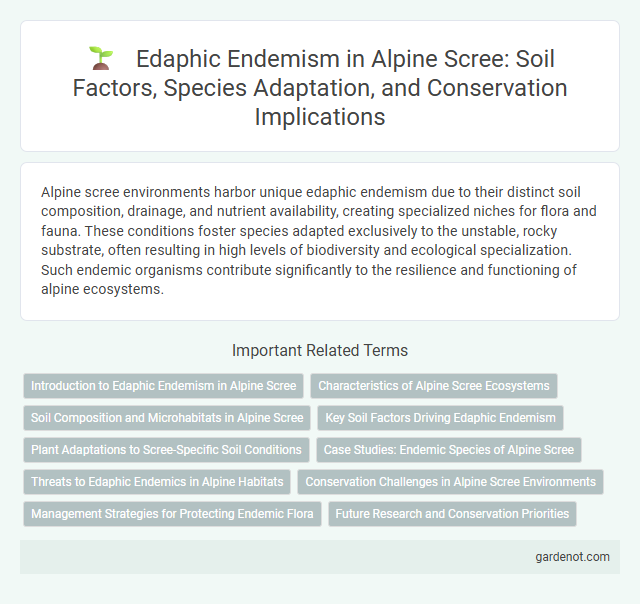Alpine scree environments harbor unique edaphic endemism due to their distinct soil composition, drainage, and nutrient availability, creating specialized niches for flora and fauna. These conditions foster species adapted exclusively to the unstable, rocky substrate, often resulting in high levels of biodiversity and ecological specialization. Such endemic organisms contribute significantly to the resilience and functioning of alpine ecosystems.
Introduction to Edaphic Endemism in Alpine Scree
Alpine scree exhibits unique edaphic endemism driven by its unstable, rocky substrate and extreme microclimatic conditions. Specialized plant species adapt to nutrient-poor, well-drained scree soils, often developing root systems that anchor in crevices and extract sparse moisture. These edaphic specialists contribute to biodiversity and ecosystem resilience in high-altitude scree environments.
Characteristics of Alpine Scree Ecosystems
Alpine scree ecosystems exhibit high edaphic endemism driven by their unique soil properties, including coarse, unstable substrates with poor nutrient availability and rapid drainage. Specialized flora adapted to these conditions show remarkable root systems and growth forms that enhance stability and nutrient uptake in rocky, mineral-rich soils. These edaphic factors create niches that support endemic species uniquely adapted to the harsh microhabitats of alpine scree slopes.
Soil Composition and Microhabitats in Alpine Scree
Edaphic endemism in alpine scree is largely influenced by unique soil composition, characterized by coarse, well-drained mineral substrates rich in gravel and rock fragments with limited organic matter. These microhabitats create highly specialized niches, where plant species adapt to extreme soil conditions including low nutrient availability and fluctuating moisture levels. The interplay of soil pH, texture, and mineral content drives the occurrence of endemic species uniquely suited to these distinct scree environments.
Key Soil Factors Driving Edaphic Endemism
Key soil factors driving edaphic endemism in alpine scree include soil pH, nutrient availability, and texture which create specialized niches favoring endemic plant species. High concentrations of heavy metals and low organic matter further restrict colonization to adapted taxa. These unique edaphic conditions result in distinct plant assemblages with limited geographic distribution.
Plant Adaptations to Scree-Specific Soil Conditions
Alpine scree environments host unique edaphic endemism due to their unstable, nutrient-poor, and well-drained soils. Plants in these habitats exhibit adaptations such as deep or extensive root systems to anchor in loose scree, tolerance to low nutrient availability through mycorrhizal associations, and morphological traits like reduced leaf size to minimize water loss. These specialized adaptations enable survival and reproduction in harsh scree-specific soil conditions, promoting biodiversity and ecosystem stability.
Case Studies: Endemic Species of Alpine Scree
Edaphic endemism in alpine scree is exemplified by species such as *Saxifraga oppositifolia* and *Sibbaldia procumbens*, which have adapted to the nutrient-poor, well-drained substrates characteristic of scree environments. These endemic plants exhibit specialized root systems and physiological traits that enable survival and reproduction in the unstable, mineral-rich conditions found at high elevations. Case studies highlight the critical role of microhabitat specificity and soil composition in driving diversification and persistence of alpine scree endemics.
Threats to Edaphic Endemics in Alpine Habitats
Edaphic endemics in alpine scree face significant threats from climate change, which alters soil moisture and temperature regimes critical for their survival. Human activities such as construction and recreational trampling disrupt fragile soil structures, leading to habitat loss and increased erosion. Invasive species further compete for limited resources, challenging the resilience of these specialized alpine plants.
Conservation Challenges in Alpine Scree Environments
Edaphic endemism in alpine scree environments results from unique soil compositions and microhabitats that support specialized plant species with limited distribution. Conservation challenges include soil erosion, climate change impacts, and human disturbance that threaten these fragile ecosystems. Effective management requires targeted protection measures and monitoring to preserve endemic species dependent on scree substrates.
Management Strategies for Protecting Endemic Flora
Management strategies for protecting endemic flora in alpine scree environments emphasize preserving soil integrity and microhabitat stability to support edaphic endemism. Implementing controlled access and minimizing trampling reduces soil erosion and disturbance, crucial for maintaining specialized plant communities adapted to scree substrates. Restoration efforts often include re-vegetation with native endemic species and monitoring soil chemistry to ensure long-term ecosystem resilience.
Future Research and Conservation Priorities
Future research on alpine scree should prioritize understanding the specific soil microbiomes contributing to edaphic endemism and their interactions with endemic plant species. Conservation efforts must focus on protecting these unique soil habitats from climate change impacts and human disturbances to preserve the intrinsic biodiversity of alpine scree ecosystems. Long-term monitoring of soil properties and endemic species distribution will provide critical data for adaptive management strategies.
Edaphic endemism Infographic

 gardenot.com
gardenot.com